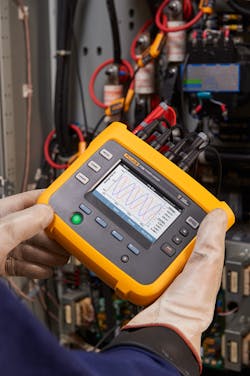Always up and running is every plant’s daily goal—that’s why you invest so much into the maintenance of the equipment and infrastructure. Of all the electrical measurements made by maintenance technicians in the pursuit of operational excellence, these are the 8 most essential.
1. Three-Point Test Method
Safety first. Before working on an electrical circuit, follow LOTO procedure, and use the three-point test method to ensure your tool is working properly. This test ensures the absence of voltage at 50 volts or more.
- Step 1: Verify the tool is working correctly by testing on a known energized source or with an electronic proving unit
- Step 2: De-energize the circuit to be verified
- The tool should indicate zero energy
- Step 3: Check your tool again using the known energized source or electronic proving unit
2. Voltage
Being able to measure both AC and DC voltage is an important feature in simplifying your motor inspections. Quickly grab a meter and begin troubleshooting power supply issues to help ensure equipment is up and working smoothly. A clamp meter or multimeter can help raise a red flag to let you know when to grab a more powerful meter.
If an issue was raised, grab a power quality meter to investigate further, look for harmonic distortion, swells or sags that may be present at the motor. These can be a sign of increases in voltage requirement throughout your building if the cause is internal. If the cause is external, it can be caused by nature, such as vegetation affecting power lines. Both are worth looking into correcting if your motor is experiencing sags or swells in power.
It’s a great option to use a clamp meter or multimeter during your regular preventive maintenance routes to look for voltage imbalance issues. Use that information to come back through later with a more powerful power quality tool to determine where the imbalance may be coming from.
3. Current
A clamp meter can help determine balanced and unbalanced loads throughout your facility. Again, these measurements will give you an idea of whether or not you need to come back through with a power quality tool to determine the unbalance.
Non-linear loads or devices that conduct current for less than the entire sine wave cause harmonics. Harmonic current flowing through system impedances generates voltage distortion. In severe instances, these harmonics can cause thermal trips or logic faults. As the voltage distortion caused by current harmonics increases, linear loads begin to draw harmonic current. In motors, the distortions can cause counter-torque resulting in more current and a host of other problems, including decreased motor efficiency, increased heating, and a shorter life of the motor.
4. Component Resistance
Checking the resistance of control circuits, like switches and relay contacts, can show what condition the components are in. The higher the resistance, the lower the current flowing through to the motor at the end. Most of the time, resistance starts out very low and increases over time; as dirt builds up, there is more wear and tear put on the components, insulation breaks down or moisture builds up.
Finding these kinds of issues and correcting them before the damage can prevent expensive repairs or asset replacement.
5. Circuit Continuity
Testing a circuit for continuity tells you whether two points are electrically connected or not. Use these checks to verify a proper connection or if there could be a break anywhere in the electrical path.
6. Circuit Loading at Panelboards (feeder cables, branch circuits, neutrals)
Sometimes a circuit load at the panelboard could cause sags down the line if the wiring isn’t adequate for the loads they feed. If this issue presents itself in your facility, correct the wiring and loading issues first, then you can try other actions to minimize the source impedance like:
- Reduce the load on the panel (if necessary and possible)
- Don’t cascade subpanels off subpanels
- Limit the length of feeder runs to subpanels
Be sure not to overload transformers as that can cause increased energy losses further down the line and ultimately cause premature failure in equipment.
7. Validate Load Measurements on Motors and Pumps
Motors and pumps are incredibly common machines in the industrial industry. Because they’re so common, they are often overlooked as the possible cause of excess costs. But when not operated properly, motors and pumps can slow productivity and cause additional problems and costs.
It’s important to make sure your load is properly balanced. Validate that the load to the motor is not overloaded with voltage or current flowing through.
8. Confirm Transformer Load and Line Voltage
When inspecting your motor, running a load test can determine the efficiency and thermal and dynamic stability of a power transformer. If the transformer is frequently overloaded, it weakens the system faster. Overloading generally causes overheating and eventually creates cracks in the insulation within the system. Using the meter, you can know what voltage and current should be coming out at the transformer, up to 1,000V line voltage. If something is off, you will need to grab a more powerful tool and continue investigating. Keeping an eye on transformer loads and line voltages during your regular preventive maintenance routes can help catch issues before they become too big.











